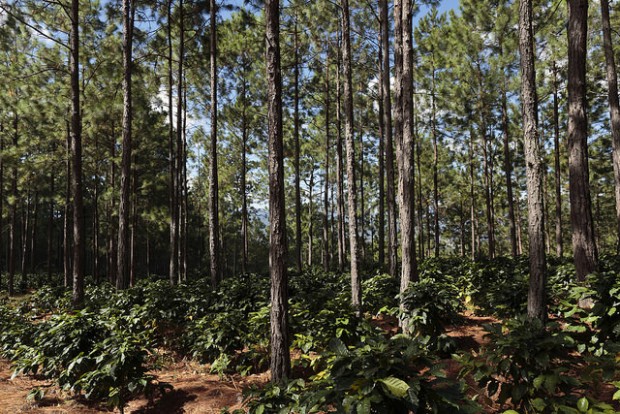by Kraig Kraft of CRS Coffeelands Blog
I’m going to be honest with all of you. I don’t have a lot of material to work with on this topic. I’ve been talking to a lot of people about this and looking all around Central America for examples of private investment in coffee farms. We all know about the pioneering work of Root Capital (congrats on 15 years and $100 million in loans!) and other social lenders, who have provided credit to coffee farmers and producers groups, but I wanted to see examples that go beyond loans.
While Root and other socially minded lenders help ameliorate the farmer’s risk through trainings, while minimizing their own exposure to risk through careful screening of loan recipients, I wanted an explicit model of direct investment in the farm. Any approach would need to deal with the issue of risk in a novel way, either sharing it or transferring it away from the farmer. As I mentioned in my last post, the World Bank’s recent report on risk and lack of access to finance and investment makes this really clear. It’s a little wonky, but worth flipping through, as it can change your viewpoint on risk. Thanks to the report, I’m viewing the coffeelands through risk-colored lenses at the moment.
In the coffeelands of Nicaragua, there is very interesting venture that proposes a new model of risk-sharing with farmers. It is led by the Moringa fund, an agroforestry impact investment fund. That’s right. An agroforestry fund. It only funds agroforestry projects that meet its criteria. In their words:
Moringa invests in projects which provide the environmental, social and economic aspects required for sustainable development. Moringa’s agroforestry projects create economic benefits for investors and local communities while contributing to building environmental and social resilience of land-use.
Moringa wants to take an equity stake in companies that have found successful agroforestry models and that have limitations at operating or disseminating the model at scale and then help these companies scale it up. Scale is a key component of this venture — Moringa’s efforts are part of Nicaragua’s 2.7 million hectare contribution to the Initiative 20×20, sponsored by World Resource Institute (WRI), whose objective is to restore 20 million hectares of forests in Latin America.
How does this actually work? In Nicaragua, the Moringa fund has invested in a large farm on the outskirts of Matagalpa, La Cumplida
. From La Cumplida, they want to finance renovation of other farms in the area under a shared risk model, using the agroforestry model that is found at La Cumplida.
It is a mix of cutting-edge approaches: new coffee varieties; data-driven fertilizer and pest control applications; strategies to minimize environmental footprint; certifications (Utz and Rainforest Alliance); and quality differentiation. They also incorporate one of the oldest innovations in coffee farming: Trees.

Shade grown coffee in pine forests, an example of an agorforestry system, in Agua Amarilla Microwatershed, Opalaca Reserve in San Juan Intibucá, Honduras
Trees are used to shade the coffee plants, to create a mulch that improves the soil’s organic matter, and to provide fruit and timber. Timber is key in this agroforestry model, as it can provide another income stream. A recent study by the Honduran Foundation for Agricultural Research, FHIA, looked at the long-term profitability of a cacao agroforestry system. The models that incorporated timber species were the most profitable over the 20 years. The timber was actually the component that brought them in the most income.
Under this renovation scheme, Moringa will pay the approximately $4,000 per hectare in renovation costs, making use of the new and advanced coffee varieties developed and sold locally by ECOM (H1 and H3 hybrids, and Marsellesa) and plant timber and shade trees. The farmer manages the plot, obtains technical assistance and under a usufruct agreement, Moringa will retain the net benefits of the coffee farm for 5 years, with the farmer guaranteed a minimum income over this time. After 5 years, the farmer takes total control over the farm, with the best productive years ahead of him.
This is truly a strategy to share risk. If the yields aren’t there, or for some other reason the farm can’t produce, it is Moringa that bears this risk for these first years. Their ability to repay the initial investment and get a return is predicated on their ability to turn the farm profitable within this time period.
Is this model better than a traditional renovation loan for 7 or 10 years loan at 10 percent with a 3 year grace period? How does a farmer cope with not getting all of the income from their farm?
We don’t have all the answers yet — this initiative is just starting. What I do know is that Moringa is making a large bet on coffee farmers. Let’s see others follow suit.
Kraig Kraft
Kraig Kraft is the CRS Technical Advisor for Coffee and Cacao for the Latin America/Caribbean. He is Based in Managua.
Comment
1 Comment
Comments are closed.






I really like your articles, funding for farmers is basically not an option in El Salvador central america i have 230ha farm and have tried to get funds for a cocoa forestry combined project with no luck, most of the neighboring farm owners to my property barely read or write so if i cant get there having acces to internet and written to almost every site, naturebank, root, etc. What chance will they have. I have read many articles that mention funding through private investors and how important the future funding for cocoa projects in latin america will be in the near future but at least in my case and many other farmers that want to grow cocoa i see it far from happening,